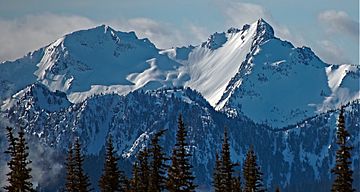Mount Appleton facts for kids
Quick facts for kids Mount Appleton |
|
|---|---|

Mount Appleton seen from Hurricane Ridge
|
|
| Highest point | |
| Elevation | 6,000 ft (1,800 m) |
| Prominence | 200 ft (61 m) |
| Geography | |
| Location | Clallam County, Washington, United States |
| Parent range | Olympic Mountains |
| Topo map | USGS Mount Carrie |
| Geology | |
| Age of rock | Eocene |
| Climbing | |
| Easiest route | Scrambling class 3 |
Mount Appleton is a tall mountain in the Olympic Mountains range in Washington state. It stands about 6,000 feet (1,829 meters) high and has two main peaks. You can find it inside the beautiful Olympic National Park, not far from Appleton Pass. The peak just south of it, called South Appleton, is a little bit taller. Water from Mount Appleton flows into the Sol Duc River and Boulder Creek, eventually reaching the Strait of Juan de Fuca.
Contents
The Story Behind Mount Appleton's Name
Mount Appleton is named after a special doctor, T. J. Appleton. He moved to Port Angeles, Washington, around 1897 from Michigan. Dr. Appleton was a very important doctor who traveled to faraway places in Clallam County to help people. He was also the first white doctor to treat Native Americans in that area.
Besides being a doctor, Appleton was a great speaker and writer. He later served as the mayor of Port Angeles three times. He passed away in 1942. We don't know who was the first person to climb Mount Appleton.
Weather and Climate Around Mount Appleton
Mount Appleton is located in a "marine west coast" climate zone. This means the weather here is greatly affected by the nearby Pacific Ocean. Most weather systems come from the Pacific and move towards the Olympic Mountains.
When these weather systems hit the tall Olympic peaks, they are forced to rise. As the air goes higher, it cools down and drops its moisture. This causes a lot of rain or snow, especially during the winter. This process is called Orographic lift.
Because of this, the Olympic Mountains get a lot of precipitation. Winters are usually cloudy and snowy. However, during the summer, high pressure systems over the Pacific Ocean often bring clear skies. The snow here tends to be wet and heavy, which can sometimes lead to a high risk of avalanches.
How Mount Appleton Was Formed
The Olympic Mountains, including Mount Appleton, are made up of special kinds of rock. These rocks were formed from pieces of old ocean floor and sediments that were pushed up over time. Most of these rocks are sandstone and basalt from the Eocene time period.
The shape of the mountains we see today was created during the Pleistocene era. During this time, huge sheets of ice called glaciers moved across the land many times. These glaciers carved out valleys and shaped the peaks as they advanced and then melted away.
Images for kids





